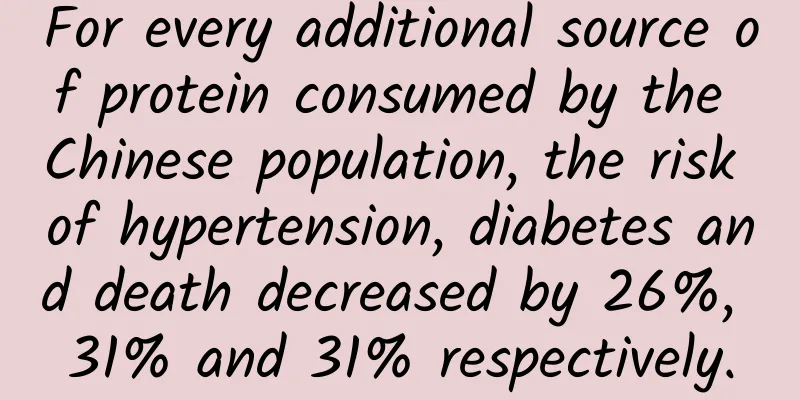For every additional source of protein consumed by the Chinese population, the risk of hypertension, diabetes and death decreased by 26%, 31% and 31% respectively.

|
As we all know, "prevention is the most economical and effective health strategy", and moving the threshold of chronic disease prevention and control forward is the top priority of building a healthy China. In 2017, one-fifth of deaths worldwide were related to poor diet; China's cardiovascular disease mortality and cancer mortality caused by poor diet ranked first in the world. The three macronutrients of protein, carbohydrates and fat are the basic substances for energy supply and maintenance of life activities. Proteins from different foods often have strong heterogeneity and show different effects due to their different types of amino acids. However, it is still uncertain whether the intake and diversity of protein from different food sources will affect the risk of hypertension, diabetes and death in the Chinese population. In response to the above problems, the National Clinical Research Center for Kidney Diseases of Nanfang Hospital, the School of Public Health of Anhui Medical University, and the Anhui Institute of Biomedical Sciences jointly conducted relevant research and published it in Hypertension (first author: Zhou Chun), BMC medicine (first author: Zhou Chun, Liu Chengzhang) and J Nutr Health Aging (first author: Zhou Chun). The study showed that among the general adult population in China, the more types of dietary protein from different sources are consumed in moderation, the lower the risk of new hypertension, new diabetes, and death. Professor Nie Jing and Professor Qin Xianhui of Nanfang Hospital are the corresponding authors.
The results show that more than 80% of the protein consumed by the Chinese population comes from eight major food groups, including whole grains, refined grains, processed red meat, non-processed red meat, poultry, fish, eggs and beans. The study found that protein intake from different food sources was nonlinearly correlated with the risk of new-onset hypertension, new-onset diabetes and death (Figure 1). In other words, for each source of protein, there is a "window" of intake, that is, an appropriate intake range, within which the risk of hypertension, diabetes and death is the lowest.
Based on the above results, the researchers further defined the diversity score of dietary protein sources: when the protein intake of each participant from a certain food source is within the appropriate intake range, it is scored as 1 point, and the total score is between 0 and 8 points. This score takes into account both the intake of food protein and the diversity of its food sources. Studies have shown that the protein diversity score is significantly negatively correlated with the risk of new-onset hypertension, new-onset diabetes, and death. That is, for every increase in the type of protein from different sources that is suitable for intake, the risk of new-onset hypertension is significantly reduced by 26%, the risk of new-onset diabetes is significantly reduced by 31%, and the risk of death is significantly reduced by 31% (see Figure 2). Figure 2. Protein diversity score is significantly negatively correlated with the risk of new-onset diabetes, new-onset hypertension, and death Metabolic diseases include obesity, hyperlipidemia, non-alcoholic fatty liver disease, diabetes, hypertension, etc. These diseases can occur at the same time and affect each other, increasing the risk of disability and premature death. Among them, metabolic disorders (stress) are the basis and core of metabolic diseases. For example, metabolic disorders lead to non-alcoholic fatty liver disease and diabetes through insulin resistance, and cause ACE system activation through central nervous system activation, peripheral inflammation and oxidative stress, leading to hypertension. Unreasonable diet is one of the important causes of metabolic disorders (stress). The above series of studies show that a reasonable and optimized diet can significantly reduce the risk of hypertension and diabetes, and thus significantly reduce the risk of death; it emphasizes the important role of a reasonable diet in the prevention and control of metabolic diseases. In summary, for every additional source of dietary protein consumed by the Chinese population (including whole grains, refined grains, processed red meat, non-processed red meat, poultry, fish, eggs and beans), the risk of hypertension, diabetes and death is significantly reduced by 26%, 31% and 31%, respectively. Dietary protein from multiple sources can ensure a richer variety of amino acids and better meet the nutritional needs of the human body, thereby providing richer biological functions and producing a series of significant health benefits. The study once again emphasized that a diverse diet, moderate eating and reasonable matching are the basis for maintaining good health . References: 1. Zhou C, Wu Q, Ye Z, et al. Inverse Association Between Variety of Proteins With Appropriate Quantity From Different Food Sources and New-Onset Hypertension. Hypertension. 2022;79(5):1017-1027. 2. Zhou C, Liu C, Zhang Z, et al. Variety and quantity of dietary protein intake from different sources and risk of new-onset diabetes: a Nationwide Cohort Study in China. BMC Med. 2022;20(1):6. 3. Zhou C, Yang S, Zhang Y, et al. Relations of Variety and Quantity of Dietary Proteins Intake from Different Sources with Mortality Risk: A Nationwide Population-Based Cohort. J Nutr Health Aging. 2022;26(12):1078-1086. Editor: Zhou Chun, Liu Chengzhang, Huang Yu Reprint: Please contact us and indicate the source |
<<: This is the Chaka Salt Lake, which is enough to feed people for 70 years! Satellite view →
>>: Why doesn't it rain diamonds on Earth?
Recommend
What are the edible effects of Cistanche deserticola?
Cistanche deserticola is a very precious Chinese ...
The cold wind is howling. Each plant has its own unique way to save its life!
In order to compete for limited sunlight and wate...
The efficacy and function of yellow water taro grass
As people's living standards improve, they pa...
What are the effects of Strong Eucommia and Gastrodia?
With the continuous development and progress of t...
What are the medicinal properties of Angelica root?
When you see this title, the first thing that com...
The efficacy and function of big head dog
Many people are not very clear about the efficacy...
After using melatonin, it will be dark when I close my eyes? NO!
Author: Zang Juxiang, Chief Pharmacist of Eastern...
"Dragon and egg coexistence" wonder! A 190 million-year-old dinosaur egg nest was discovered →
Recently, paleontologists discovered a special di...
"Xuelong 2" sets off! China's 13th Arctic Ocean expedition team sets out
On July 12, the 13th Chinese Arctic Ocean scienti...
What is the effect of washing hair with Platycladus orientalis leaves?
We all know that people with a hot constitution a...
The road to the darkening of insects: Why do locusts change their temperament drastically after gathering into swarms?
Locusts are one of the major global agricultural ...
The efficacy and function of Tianqingdihong
Traditional Chinese medicine has always been the ...
Effects and functions of Lengshuidan
There are many types of Chinese medicine. When we...
Sitting by the window on an airplane can cause serious damage to your skin?
Friends who have taken a flight know that the win...
The efficacy and function of Dafeijingcao [picture]
Big lung meridian grass [picture] is a medicinal ...









